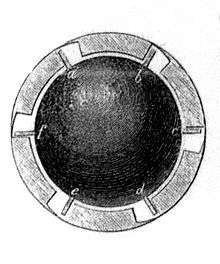Round shot

A round shot (or solid shot, or a cannonball, or simply ball) is a solid projectile without explosive charge, fired from a cannon. As the name implies, a round shot is spherical; its diameter is slightly less than the bore of the gun from which it is fired.
The cast iron cannonball was introduced by French artillery engineers after 1450 where it had the capacity to reduce traditional English castle wall fortifications to rubble.[1] French armories would cast a tubular cannon body in a single piece and cannonballs took the shape of a sphere initially made from stone material. Advances in gunpowder manufacturing soon led the replacement of stone cannonballs with cast iron ones.[2]
Round shot was made in early times from dressed stone, referred to as gunstone (Middle English gunneston, from gonne, gunne gun + stoon, ston stone), but by the 17th century, from iron. It was used as the most accurate projectile that could be fired by a smoothbore cannon, used to batter the wooden hulls of opposing ships, fortifications, or fixed emplacements, and as a long-range anti-personnel weapon. However, masonry stone forts designed during the early modern period (known as star forts) were almost impervious to the effects of roundshot.
Grapeshot and round shot were some of the early projectiles used in smoothbores.
In land battles, round shot would often plough through many ranks of troops, causing multiple casualties. Unlike the fake gunpowder explosions representing roundshot in movies, real roundshot was more like a bouncing bowling ball, which would not stop after the initial impact, but continue and tear through anything in its path. It could bounce when it hit the ground, striking men at each bounce. The casualties from round shot were extremely gory; when fired directly into an advancing column, a cannonball was capable of passing straight through up to forty men. Even when most of its kinetic energy is expended, a round shot still has enough momentum to knock men over and cause gruesome injury.
When attacking wooden ships or land structures that would be damaged by fire, the cannonball would be heated to red hot. This was called a "hot shot". (On the shot called "the single deadliest cannon shot in American history," see Negro Fort.)
Round shot has the disadvantage of not being tightly fitted into the bore (to do so would cause jamming). This causes the shot to "rattle" down the gun barrel and leave the barrel at an angle unless wadding or a discarding sabot is used. This is known as 'windage.'
Round shot has been totally replaced by modern shells. Round shot is used in historical recreations and historical replica weapons.
In the 1860s, some round shots were equipped with winglets to benefit from the rifling of cannons. Such round shot would benefit from gyroscopic stability, thereby improving their trajectory, until the advent of the ogival shell.[3]
Notes
- ↑ Maier, Charles S. (2016). Once Within Borders: Territories of Power, Wealth, and Belonging since 1500. Harvard University Press. ISBN 978-0674059788.
- ↑ Martello, Robert (2010). Midnight Ride, Industrial Dawn: Paul Revere and the Growth of American Enterprise. Johns Hopkins University Press. p. 174. ISBN 978-0801897580.
- ↑ Musée de la Marine, Paris
See also
External links
| Wikimedia Commons has media related to Cannonballs. |
- Photo of stone round shot from the Castello Sforzesco in Milan, Italy
- "A Guide to Geometry, Surveying, the Launching of Missiles, and the Planting of Mines" features 18th century schematic drawings of cannonballs from the Muslim world via the World Digital Library